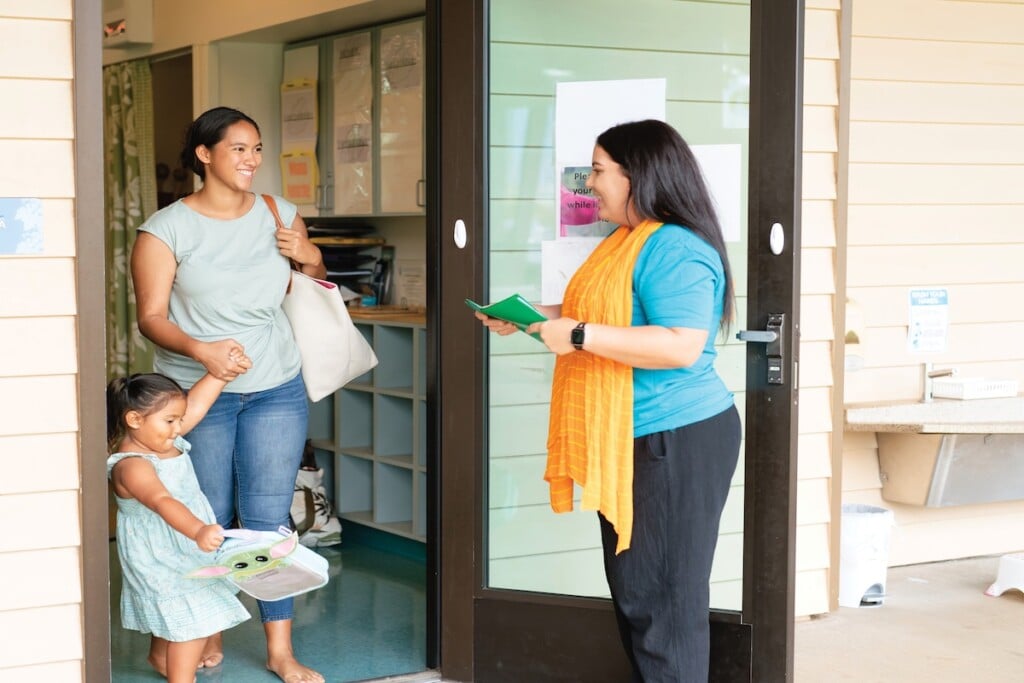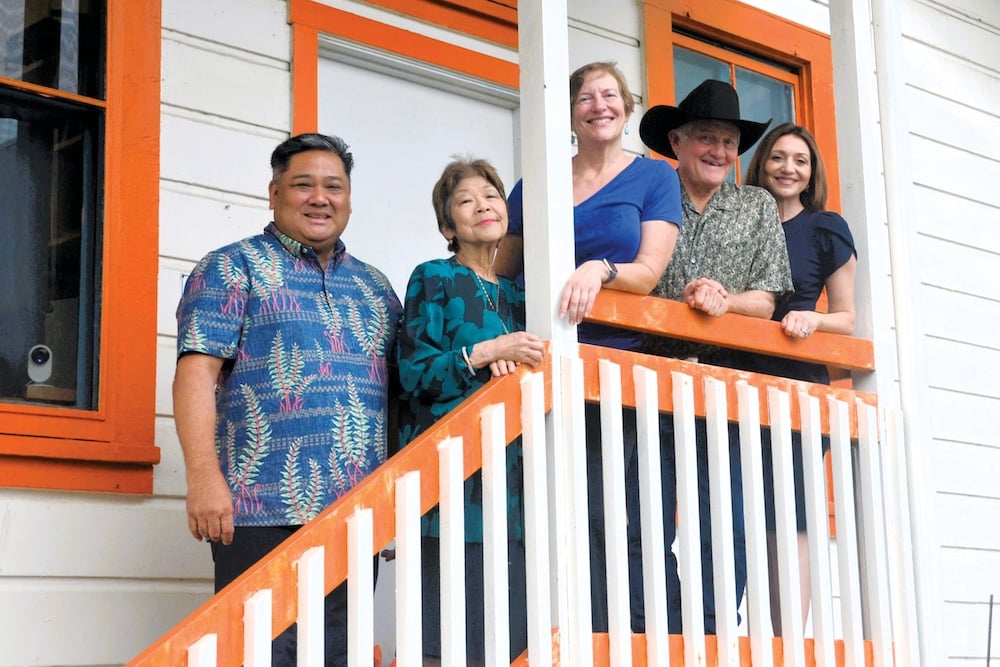Artificial Intelligence in Hawai‘i K-12 Education – Part 1
They recognize AI’s challenges and long-term unknowns, but they also believe that with proper guardrails, AI is already enhancing education, and students are benefiting. These early adopters are riding the wave, not trying to hold it back, and here’s how they’re doing it.

Part I: Meet the Early Adopters in Our Schools
Public school computer science teacher Miki Cacace noticed her daughter struggled to read long passages of text. So Cacace developed a custom AI chatbot that added more white space. Now she has “beautiful reading comprehension,” says Cacace, an award-winning resource teacher in the state Department of Education’s Office of Curriculum and Instructional Design.
Cacace also used AI to help her daughter improve her math and music skills. After they created a song using AI, her daughter told Cacace: “That’s not mine. It’s my ideas, but now I’m going to use this to make it my own.”
“That’s what we need to make students understand: How do I use it to make it my own and use AI as a tool to help me grow,” Cacace said at a panel on AI during Honolulu Tech Week in September.
She is exploring the many possibilities for individual learning using AI and now trains other DOE teachers on how AI tools can save them time and personalize instruction to best fit students’ needs.
LOCAL LEADER IN AI EDUCATION
Another early adopter is Gabriel Yanagihara, an ʻIolani School teacher in emerging technologies such as game design, AI and fabrication. He says he wants everyone in Hawaiʻi to be AI literate, and he’s working toward that goal.
He leads free workshops and boot camps for students and parents, consults for organizations, and has a newsletter and website of free resources (gabrielyanagihara.com). He says he wants parents to learn how the tools work so they can best guide their children in their use.
His students use AI to brainstorm, debug software code, generate visuals, and write dialogue or scripts for their projects. They are creating video games, websites, apps and even books from scratch.
“We don’t just allow AI; we structure how it’s used,” Yanagihara says. “I train students on specific tools and show them when it makes sense to bring AI in and when it doesn’t.” Class projects that were once just “dream-level” are now standard.
He says AI tools have made him more efficient and effective – he has his personal life and weekends back – while improving student outcomes.
Yanagihara says not all schools can afford licenses for AI tools that have guardrails to protect student data. Free versions often lack those guardrails. “That worries me, because it creates an equity gap. My students have 24/7 AI access tied to my lessons, and I can track how they use it in class. Most students in the state don’t have that,” he says.
However, many of AI’s early adopters hope it can enhance equality in education. Candace Cheever, K-12 director of teaching and learning at Punahou School, is optimistic that some AI technology might democratize learning by making tutors accessible to everyone.
AI WILL SOON BE EVERYWHERE
Artificial intelligence is not going away, whether you like it or not, leaders in the field say, and educators must accept and guide the transformation – not be swept away by it. But that transformation won’t be easy.
“This is going to be a huge disruption to our education system,” says Winston Sakurai, executive assistant and chief of staff at the DOE’s Office of Curriculum and Instructional Design.
“Moving a system like we have is very challenging,” Sakurai said at a panel discussion during Honolulu Tech Week. Change, he added, will happen “one classroom at a time, one school at a time” until AI is “like the air we breathe.”
To leverage it for student success, he encourages teachers to try AI and get comfortable with it, so they feel less threatened.
Michael Ida, “Dr. Ida” to his students and colleagues, teaches computer science and math at Kalani High School. He says AI is far more transformative than previous technological advances. “Unlike a search engine or gradual tool upgrades, its range of capabilities – whether generating lesson plans, activities or hyper-realistic images and video – suggests it will fundamentally change professions and daily life,” Ida says.
Most people have trouble recognizing what’s generated by AI. When Cacace trains DOE teachers, she shows them two images of children in a garden: one real and one generated by AI with students it created. Many teachers cannot tell the difference. Her point is that teachers need to learn to understand the basics of how AI works in terms of computer science fundamentals so they can guide students in using AI tools.
“Because if we as teachers are not educating ourselves with these new technologies, how do we then teach our students to be safe and effective users of technology?” The key, she says, is teachers and schools need to choose tools and methods for powerful student learning – instead of students “using it as just something to cheat or something to just get a quick answer from.”

When training teachers about AI, Miki Cacace will show this AI-generated picture and a picture of real children. Many teachers can’t tell which is real. She says, “If we as teachers are not educating ourselves with these new technologies, how do we then teach our students to be safe and effective users of technology?”
AI DESIGNED FOR EDUCATION
Magic School is a national AI platform designed to comply with laws that protect children under age 13, though older students can use it too.
Since November 2024, about 1,500 DOE teachers have been trained on Magic School, which is currently free for them, and they use it for lesson planning and student assignments that they can complete on the Magic School platform. Student data is protected and private, and most work on school devices that are kept at school.
Magic School says its software serves diverse learners, saves teachers time and improves student results.
In Hilo, Waiākea Intermediate School social studies teacher Jonathan Peralto says Magic School is “a lot of fun.” He says the platform’s chatbot, named “Raina,” has helped him improve his lessons and planning. Now, he says, he can modify lessons in minutes instead of hours.
Using Magic School, his U.S. history students role-played Oregon Trail characters, and then wrote three journal entries for their characters’ experiences, with details about their journeys. Then the students could generate images for each entry.
Before Magic School, Peralto used a social studies tool called Humy.ai, with chatbots that mimicked historical figures. Students interviewed George Washington, then asked Thomas Jefferson about writing America’s founding documents. A debate with James Madison taught them about the U.S. government and Constitution.
Peralto and other social studies teachers are now dabbling with a Magic School writing-feedback tool for short responses that students write in class. “It’s pretty unbelievable,” he says, because giving feedback is less burdensome and he can reach more students individually. That’s crucial because each social studies teacher at his school has 130-140 students.
Peralto has also tested AI writing-feedback tools, which help him automate feedback for individual students based on his curriculum. One tool also identified common issues among students’ work, helping him target instruction to build specific skills like citing evidence.
THE URGENCY TO DO WHAT WE SHOULD DO
At ʻIolani School, faculty can use Magic School AI with students from 2nd to 12th grade. “Its strength is that teachers can assign specific AI tools for a class and then turn them off afterward, so it supports intentional use for particular activities,” Yanagihara explains.
ʻIolani high school students will be trying Google’s Gemini AI this year, and already have Perplexity AI and Magic School through their teachers. These are provided under educational licensing currently for select students, which protects teacher and student data.
“I love the AI because it creates the urgency to do what we should have been doing with education for the last 20 years,” Yanagihara says. “You don’t just grade the final paper that’s turned in.”
For example, he uses Magic School for his seventh graders; with it, the students create an idea for a game and include three arguments to discuss. Then Yanagihara assigns each of them a chatbot they can interact with as a thought partner while they are writing their ideas for their game design. The students write a 12-page document that covers details about the game, from the concept and story ideas to the code they need to write. They also include a list of resources. It’s both technical and creative writing.
“I give them access to the tool, and when it’s done – time for the test – I turn the room (in Magic School) off, and then it’s back to me,” Yanagihara says. He can see their chat histories, and Magic School warns him if a student is doing something that’s off-task or concerning.
Yanagihara uses an AI tool that gives students instant feedback on technical things based on his scoring rubric, which assesses things like correct grammar and paragraph structure, after they upload their assignments into that tool. He says using these tools cuts his grading time by 90%. That gives him more time to build relationships with students.
He notes that using AI for assessment can also lighten the burden for English teachers, who grade thousands of papers.

Educators, students and tech leaders gathered at ʻIolani School in September to discuss AI’s evolving role in education. Among those participating from ʻIolani were teacher Gabriel Yanagihara, left, and students Thomas Macchiarulo and Maya Gonsowski.
EXPERIMENTING AND SHARING RESULTS
At Punahou School, 35 teachers volunteered as AI innovators this year, according to Cheever, Punahou director of teaching and learning, who is also an English teacher. For that they receive a small stipend. Their mission, Cheever says, is to “lean in to experimenting with uses for teaching and learning with AI and sharing out what’s working with their colleagues.”
Several English teachers at Punahou signed up to develop an AI literacy and ethics unit in ninth grade, the grade in which many new students join the school. And teachers of fourth through eighth grades get help implementing AI, particularly in the health class that all students take in middle school. In high school English classes, Punahou says, “teachers selectively incorporate AI into specific instructional units to enrich learning, amplify students’ ideas and voices, and ensure that their own critical thinking remains central to the work.”
Punahou Mandarin language teachers Elisa Lo and Joy Lu-Chen signed up for Magic School to learn how to use AI at different levels of Mandarin, then shared their time-saving knowledge with teachers of other foreign languages.
They created custom chatbots to help students and got feedback on their learning. In one level 3 chatbot, “We’d create the prompt and feed it all the information we thought it would need and then have students interact with AI in different ways,” Lo explains. For example, there were grammar patterns and vocabulary the teachers wanted the students to learn.
The teachers created two chatbots that students could interview about student life at Peking University – living on campus and off. Then the students compared what they learned from the chatbots with their peers.
Lu-Chen also integrated Speakology AI into all her classes to provide students with opportunities to practice interpersonal speaking through simulated video chats.
Despite all these uses for AI, the final exam is still a live, in-person conversation.

Among those leading the introduction of AI into K-12 education in Hawaiʻi are, left to right, Brian Grantham of Mid-Pacific Institute. Jonathan Peralto of Waiākea Intermediate School and Winston Sakurai of the Hawaiʻi Department of Education.
EARLY ADOPTER SCHOOL
Mid-Pacific Institute, which still emphasizes a broad education for all its students, was an early adopter of AI. Among its offerings is an Immersive Technology Program.
Brian Grantham, director of educational technology for Mid-Pacific, trained a theater teacher on NotebookLM, a Google platform designed as an AI research tool and “thinking partner.”
“I asked her to give me a famous artist that you talk about in class” and she suggested the famous English actor and director Laurence Olivier. They researched him and created a podcast with two people discussing his acting techniques.
“She was blown away with the accuracy of it,” Grantham says. “This is the same thing that she would always talk about in class, but now she could basically create the podcast and have two people discuss the acting techniques and how he embodied his characters, which comes off way differently than a lecture. And now it has a video feature where it will create a video of interaction.”
Chris Ferry of Mid-Pacific – an English as a second language teacher who calls himself a “champion of multilingual and inclusive learning” – uses AI to differentiate lessons for different kinds of students, whether they are multilingual or have ADHD or dyslexia.
“You will drive yourself into the ground, as a lot of teachers do, trying to prepare materials the proper way for different students,” he says.
AI tools help him design content for individual learners at their language level, which works better than them just using a translator. He follows the Common European Framework for Languages, which works well with AI and can create reading assignments at different levels.
STUDENT AMBASSADORS SHOW AND TELL
Some motivated students have appeared at events and in videos as AI ambassadors, including those at Mid-Pacific Institute and ʻIolani School. A lot can be learned from students, educators say.
One example is former Mid-Pacific student ambassador and now alumna Gianna Groves. She says she was afraid to use AI at first because many people associate it with cheating, but she found it helped her reach her goal: She has been accepted to the architecture school at the Savannah College of Art and Design in Georgia. Before that, while learning derivatives in a calculus class at Mid-Pacific, her teacher used a particular method that worked well for her. But when she used ChatGPT to help with a derivative problem, she didn’t understand what the AI was telling her. So she asked the chatbot to use her teacher’s method instead; when it did, she understood what the chatbot was saying.
“That was a pivotal moment for me,” Groves says. “It’s not just a tool there by itself.” The AI tool sometimes needs you to explain to it how you learn, she says. “It enhances your ability to learn and to understand things. It can empower you to be you.”
Mid-Pacific expects students to be transparent in how they use AI. Students must be able to explain their assignments and how they did them, Grantham says. They must be able to evaluate AI work for accuracy and bias, and know that it should not replace their own ideas or thinking. They are also not allowed to disseminate harmful content.
If a student can’t explain what they wrote, that means they used AI as a shortcut that harms their actual learning. “But if you can talk to me about it, and it’s somewhere close to what you wrote, then you use the AI to deepen your understanding.”
ʻIolani students Maya Gonsowski and Thomas Macchiarulo are student directors of ʻIolani’s Digital Literacy Ambassadors program. Some teachers have allowed them to test AI tools like Perplexity AI for research or assess ChatGPT’s ability to write a paper. They say they want to learn about AI but can’t if most teachers don’t want it in their classes.
“I need at least one course to give me the support to fully understand AI and its capabilities,” Macchiarulo said at a public panel organized by Yanagihara.
He and Gonsowski say students need to be familiar with AI before they’re in college or in the workforce, and teachers should be preparing them for that future now.
This Charter School Is Surfing the AI Wave
Kūlia Academy, a public charter school on Oʻahu, is the first school in the U.S. to offer a seven-year AI and data science program to “grow engineers,” says Executive Director Andy Omer Gokce.
“We need to surf this wave,” he says. The school is located at 2340 Omilo Lane, near the H-1 Freeway and off Kamehameha IV Road, in the former school building for St. John the Baptist Catholic Church. He says students are coming from across Oʻahu: Waiʻanae, Mililani, Kailua, Kāhala and elsewhere.
Kūlia Academy launched in 2024 with a sixth grade class. This year, there’s a seventh grade class as well, and another grade will be added each year through 12th grade. Current enrollment is 150 and is open to all students in available grades.
The academy’s website (kuliaacademy.org) announced in September that the school achieved the highest proficiency scores among all middle and high schools in Hawaiʻi, according to the Strive HI 2024-25 state test results. In math, the school had a 75% proficiency score; in English, it scored 80%. (A student is considered proficient if their test score meets or exceeds the benchmark level set by the state.)
School is from 8 a.m. to 4 p.m., and most student work is done at school with little homework. Teachers are paid on a 12-month contract and teach in the summer; they can also choose to stay from 3-4 p.m. for extra pay. That keeps salaries competitive, and the teachers union supported this arrangement, Gokce says.
He explains that some households are not suited for doing homework, so students get almost everything done at school, where teachers can monitor them.
And the teachers have fewer students to supervise than regular public school teachers. The teacher load is about 70 students compared with 130 to 150 students in a public middle school, Gokce says, allowing teachers to know their students well.
Gokce, formerly a charter school administrator in California, helped launch the school after years of work with the Hawaiʻi Department of Education; most of his co-founders are now members of the academy’s board. Their goal is to have a public school that prepares students for emerging technologies.
They looked at STEM school models for children that were taught at MIT, Stanford and UCLA, among other institutions.
While Kūlia Academy is focused on AI and data science, students learn to manually code before they use AI so they can understand how algorithms work. They cannot use ChatGPT to produce code. And they learn Python, HTML and later, C++ programming.
The school controls how students use technology, Gokce says, and students are not allowed to bring phones or other devices to school. Instead, they use computers the school purchased with help from a federal grant.
“We have plenty of devices here; maybe double the number of students,” Gokce says. “We have computers and iPads and iMacs here at this school.”
Students also take English, social studies and science, and have other options such as drone programming, music and sports. The school has added environmental science, a subject that often involves a lot of data particularly relevant to Hawaiʻi.
English teachers collaborate with AI and data science classes when students write about data science information and present reports in groups.
Gokce explains that students have to defend their reports, not just present the data. “We ask them to come up with conclusions. What does it mean? Where do we go from here? They need to come and defend what they are proposing.”
He uses a metaphor to explain the focus of the school: “Our aim here is to put them in the kitchen: to design the algorithms, to design AI models.” Students will learn how something works, he says, and that includes computer engineering.
“We want to designate a place where students can take a computer, take it apart, put in some RAM, change the GPU, attack it, install Linux, attack it, harden it, and then attack it again. So, the idea is for them to understand the architecture behind it, how it works.”








